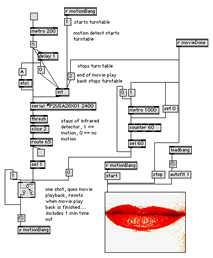

|
Workshops in the Sea of SoundAll workshops take place at the Ortona Armoury (9722-102 Street)Friday, June 24, 1 pm - 5 pm Surround Sound Creation Workshop
|
This workshop is an introduction to Max, an Object Oriented Interactive Programming Environment for the Macintosh computer. Max is a software toolset of predefined software objects that can handle MIDI communication, graphics, serial operations complex mathematical operations, music, audio, video, TC/IP, etc. Objects are put together in patches. Each patch represents an operation of data handling. Sound, QuickTime movies, animation, video, lighting, music, robotics, etc. can be made to be interactive or reactive. Max has open architecture design which allows users to make their own data handling objects using the C programming language. The Max users community also share their programming knowledge and custom objects. Max has the ability to create stand-alone applications which can be easily distributed. |
 |
Sunday, June 26, 1 pm - 4 pm
The Basic Stamp programmable microprocessor will be introduced including how to interface it with Max (see the previous workshop). The Stamp is a tiny inexpensive microcomputer, which can be easily programmed to assist in data collection, sensing devices, AC/DC motor controllers, and interfaces to any computer. It can also be used in stand-alone applications with out a host computer such as, monitoring an infrared motion detector and turning on a motorized device when a human is sensed in proximity to an installation.
 |
 |
|
 |
||